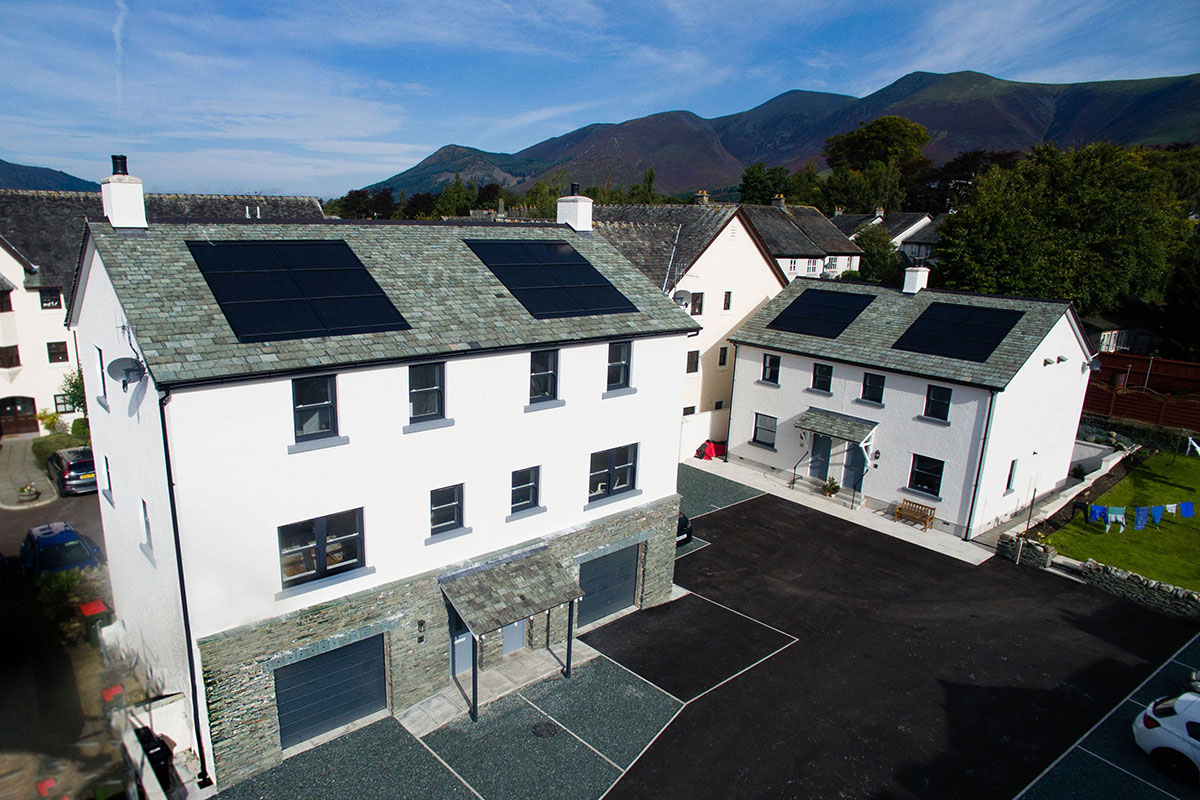In-roof solar panels

What are the benefits of roof integrated PV?
What is integrated PV?
The important difference between 'in-roof' PV and rail-mounted, on-roof solar is that integrated panels replace the roof slates or tiles - so they are part of the roof itself, rather than sitting on top of it. This technology is becoming increasingly popular in new-build properties or re-roofing projects.
EASY MAINTENANCE:
Since the solar panels sit flush with the tiles or slates, there is no space for birds to nest underneath - so there's no risk of damage to the system, and no need to bird-proof your system using Birdblocker.
Roof maintenance is much more straightforward, as you won't need to dismantle your PV system (and involve an electrician or solar installer!) to carry out any roofing repairs.

IMPROVED AESTHETICS:
Integrated panels give the system a sleek aesthetic due to their flush appearance, and make the panels appear a deliberate part of the roof design, rather than a later add-on. This more modern finish makes integrated PV a very attractive option for new build projects but also retrofits, and is often seen as the biggest selling point of in-roof PV.
Unobtrusive, streamlined in-line PV is also less likely to be met with opposition when it comes to planning permission.
QUICK AND EASY INSTALLATION:
In-roof PV can be installed very easily, especially on new builds. Since the solar panels form part of the roof, fewer tiles are required and installation time is reduced. Many such systems are design for quick fitting - for example, SolFiT uses a very simple interlocking framing system, that also speeds the process along. Their system has no fiddly seals, gaskets, or lead to worry about. The flashings are an easy fit, with no cutting required, and since the panel is itself the mounting system, there's no plastic frame to install first.
If you decide not to use a bespoke system like SolFiT, in-roof frames like GSE are an inexpensive option that also still allow you to choose from most solar panels available in the UK. Installed portrait or landscape, on all roof types and between pitches of 12°-50°, these are an easy and accommodating install option.
Installation of bespoke in-roof PV systems, especially in new build projects, can be very straightforward.
COST SAVINGS:
Tiles are expensive; covering a lot of your roof surface in solar panels instead greatly reduces the material to cover it, cutting costs both in terms of materials required and labour time during the install. This reduction in expense helps to offset the cost of the PV for a new build developer, as well as anyone re-roofing a property.
INCREASED SAFETY:
With no gaps between the roof tiles and the panels, integrated panels are more secure in high winds, outperforming mounted systems in this regard. This helps new builds meet relevant building requirements, and reduces the likelihood of needing to carry out repairs in the future.
MARGINAL GREEN GAINS:
Beyond the obvious green energy gains of any PV system, reducing the tiles needed to cover a roof also lessens the environmental impact of a project, given the inherent carbon emissions associated with the production of fired clay tiles. And in the race to reach net zero carbon, every saving helps!

What is the scope of applications for in-roof PV?
Integrated PV is suitable for all scales of project! Smaller systems look sleek on residential roofs, but are equally at home on commercial buildings and in industrial settings.
For example, EvoEnergy recently completed the UK's largest in-roof system using SolFiT panels on a new set of office buildings with a 125kWp system using 378 panels!
Disadvantages of using integrated PV - what's the deal with overheating?
Unlike raised panels, integrated solar panels sit flush in the roof surface, so don't benefit from as much air ventilation. And, since solar panels operate more efficiently at lower temperatures, this is commonly cited as the chief drawback of this option.
However, the reduction in energy yield has only been found to be a matter of less than 4%. Many customers will see the improved aesthetics as more valuable than the slight loss of efficiency anyway.
What's more, some systems such as SolFiT do actually have ventilation options which, although not offered as standard, do present the possibility to narrow the gap in efficiency, through using counter battened roofing and vented components.
Midsummer's in-roof PV options include the innovative SolFiT Top Loader BIPV, as well as GSE mounting systems.
If you have any more questions about in-roof PV that aren't answered on this page, feel free to drop us a line on social media, by email, or by calling the office. All contact details are at the bottom of the page.